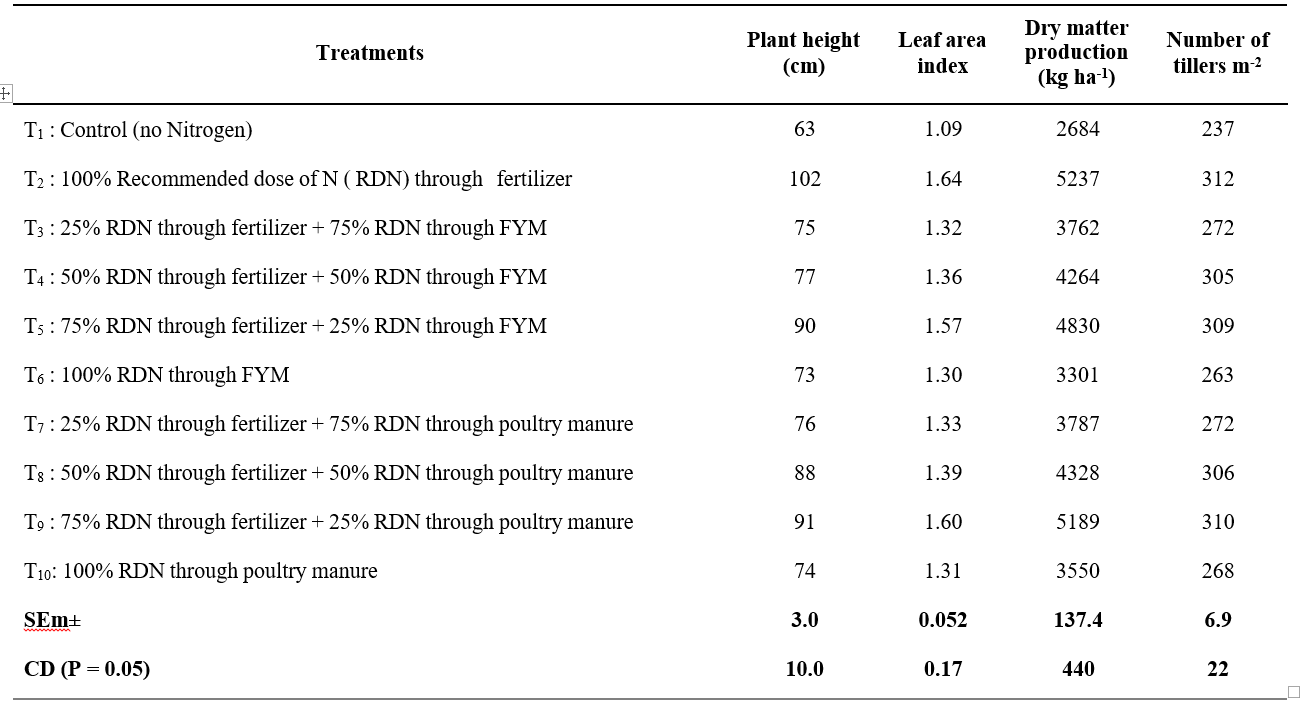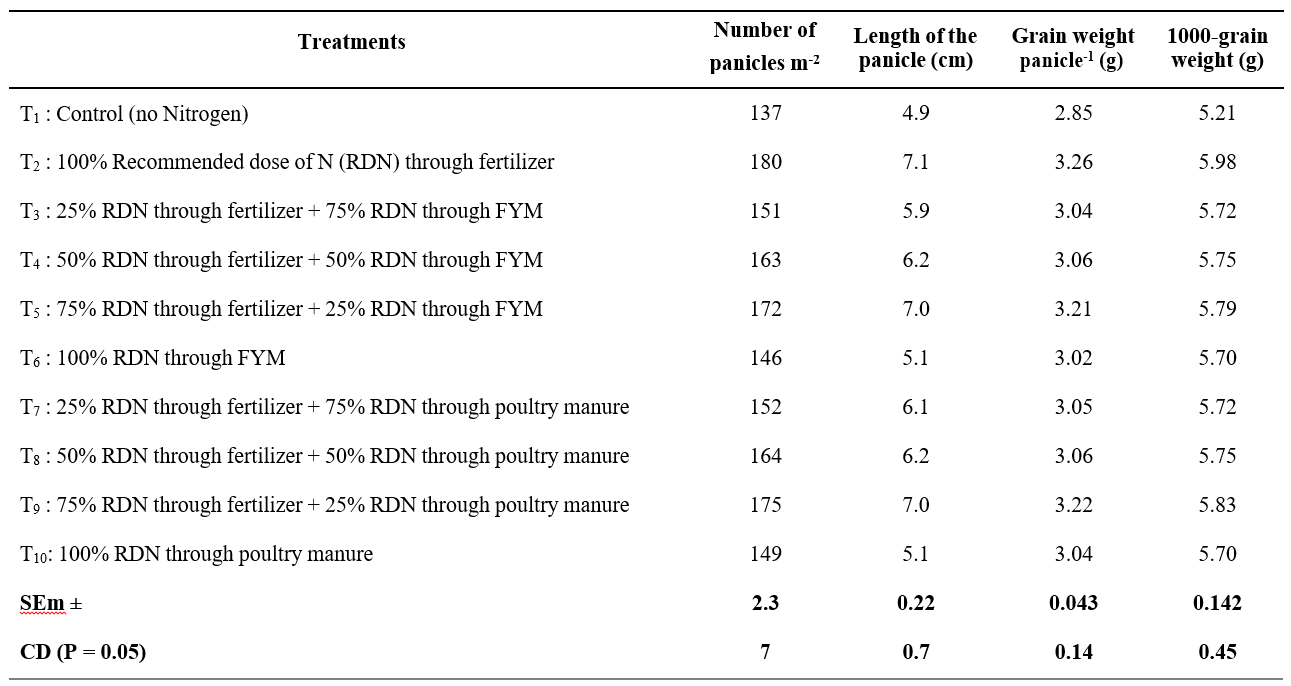Growth and Yield Attributes of Kodo Millet (Paspalum Scrobiculatum L.) As Influenced by Integrated Nitrogen Management
0 Views
S. HEMALATHA*, G. PRABHKARA REDDY, V. CHANDRIKA, M.V.S. NAIDU AND G.KARUNA SAGAR
Department of Agronomy, S.V. Agricultural College, ANGRAU, Tirupati – 517 502
ABSTRACT
A field experiment was conducted during kharif, 2020 to study the effect of different nitrogen management practices on growth and yield attributes of kodo millet. The experiment was laid down in a randomized block design, replicated thrice with ten treatments of different combinations of nitrogen sources viz., inorganic fertilizers, farm yard manure and poultry manure. The results revealed that the growth parameters and yield attributes were found at their best with the application of 100% RDN through fertilizer (T2). Among the organic sources tried, 75% RDN through fertilizer + 25% RDN through poultry manure (T9) and 75% RDN through fertilizer + 25% RDN through FYM (T5) was proved to be the most promising integrated nitrogen management practice.
KEYWORDS: Farm yard manure, kodo millet and poultry manure.
INTRODUCTION
Kodo millet holds a pivotal role among the minor millets since it has a unique drought-tolerant nature and nutritious profile. It is recommended for diabetic patients as it is having less glycemic index. In the present system of intensive agriculture, most of the farmers are using exhaustive high yielding varieties of the crops which led to heavy withdrawal of nutrients from the soil during the past few years and fertilizer consumption remained much below compared to removal. This gap between nutrient removal and supply cannot be bridged by fertilizers alone. It can be achieved through integrated nutrient supply system (INSS).
Nitrogen is very important component of any fertilizer management programme. Application of only chemical fertilizers has a great effect on soil health and environment. Despite, fertilizers increases the food production but it leads to the micronutrient deficiencies. Organic manures such as poultry manure and farm yard manure not only increase the crop yield but also leads to increased quality of the produce. Integration of chemical fertilizers with organic manures has been found quite promising not only in sustaining the soil health and productivity but also in stabilizing the crop production in comparison to the use of each component, separately.
MATERIAL AND METHODS
A field experiment was conducted during kharif, 2020 at S.V. Agricultural College Dryland Farm, Tirupati Campus of ANGRAU, on sandy loam soil with pH 7.72 having medium organic carbon content (0.73%), low in available nitrogen (250.9 kg ha-1), medium in available P2O5 (16.2 kg ha-1) and available K2O (173.4 kg ha-1). The experiment was laid out in randomized block design with ten treatments and replicated thrice. The treatments were Control (no Nitrogen) (T1), 100% RDN through fertilizer (T2), 25% RDN through fertilizer + 75% RDN through FYM (T3), 50% RDN through fertilizer + 50% RDN through FYM (T4), 75% RDN through fertilizer + 25% RDN through FYM (T5), 100% RDN through FYM (T6), 25% RDN through fertilizer + 75% RDN through poultry manure (T7), 50% RDN through fertilizer + 50% RDN through poultry manure (T8), 75% RDN through fertilizer + 25% RDN through poultry manure (T9) and 100% RDN through poultry manure (T10). The test variety of kodo millet ‘GPUK-3’ was sown on 17th July 2020 keeping a seed rate of 10 kg ha-1 and row spacing of 25 cm and plant spacing of 10 cm. The organic and inorganic sources of nutrients were applied as basal according to the specified treatments. Half of the nitrogen was applied as top dressing at 30 days after sowing. The observations were taken using destructive and non-destructive sampling methods. Five plants in each net plot were selected and tagged in each treatment for recording periodical observations on growth parameters at 30 days interval and yield attributes at harvest. For recording leaf area and dry matter production, destructive sampling was done by taking 5 hills each time from the border rows, leaving the extreme row of the plot. The data recorded on various parameters of crop during the course of investigation was statistically analyzed following the procedure given by Panse and Sukhatme (1978).
RESULTS AND DISCUSSION
Growth attributes
The results showed that integrated nitrogen management involving combined use of inorganic fertilizers, farm yard manure and poultry manure significantly influenced the growth attributes of kodo millet viz., plant height, leaf area index, dry matter production and number of tillers m-2 (Table 1). The higher growth attributes of kodo millet were noticed with 100% RDN through fertilizer (T2). This might be due to quick release and availability of nutrients and especially nitrogen, which is an important constituent of protoplasm playing a positive role in cell division and elongation. Nitrogen being the prime nutrient, directly influences the plant growth and development through increased cell division, resulting in taller plants, larger leaf area and enhanced tillering, leading to increased dry matter production through larger photosynthesizing surface. The next higher values of growth parameters were noticed with the application of 75% RDN through fertilizer + 25% RDN through poultry manure (T9), 75% RDN through fertilizer + 25% RDN through FYM (T5) and 50% RDN through fertilizer + 50% RDN through poultry manure (T8). This might have provided adequate plant nutrients in the soil for plant nourishment and further organic manures releases nutrients slowly and continuously which enhanced cell division, elongation as well as various metabolic processes which ultimately increased the growth attributes of the kodo millet. Increased growth parameters with recommended level of N through either completely inorganic sources or combination of organic and inorganic sources, has been established by Duryodhana et al. (2004), Sunitha et al. (2004), Giribabu et al. (2010), Kumar et al. (2014) and Togas et al. (2017). The lowest values recorded with control might be due to non-availability of sufficient quantity of nutrients to produce even a moderate stature of kodo millet crop.
Yield attributes
Among the treatments tried, 100% RDN through fertilizer (T2) recorded the highest yield attributes viz., number of panicles m-2, length of the panicle, grain weight panicle-1 and thousand grain weight. Among the organic sources of nutrients tried, 75% RDN through fertilizer + 25% RDN through poultry manure (T9) and 75% RDN through fertilizer + 25% RDN through FYM (T5) exerted a synergetic effect on the yield attributes of kodo millet. The favourable effect with 100% RDN through fertilizer (T2), 75% RDN through fertilizer + 25% RDN through poultry manure (T9) and 75% RDN through fertilizer + 25% RDN through FYM (T5) on growth parameters was subsequently reflected in improving the yield attributes like number of panicles m-2, length of the panicle, grain weight panicle-1 and thousand grain weight (Table 2). Increased availability of nitrogen with these treatments would be coincided with the peak nitrogen demand of crop growth stages (seedling establishment, active tillering and panicle initiation) due to which most of the panicles m-2 were produced. Better vegetative growth resulted in efficient dry matter accumulation and effective partitioning to the panicle resulted in longer panicles, higher grain weight panicle-1 and thousand grain weight. Similar reports of higher yield attributes with inorganic sources or integrated use of organics and inorganic sources of nitrogen were reported by Khan et al. (2000), Sunitha et al. (2004), Pratap et al. (2008), Govindappa et al. (2009), Archana (2018) and Ojha et al. (2018). Reduced stature of growth parameters has reflected in deflated yield attributes in control (no Nitrogen) (T1) with non-supply of nitrogen.
In conclusion, the present investigation revealed that higher growth and yield attributes of kodo millet could be realized with 100% RDN through fertilizer. Among the different organic sources of nitrogen tried, application of 75% RDN through fertilizer + 25% RDN through poultry manure (T9) and 75% RDN through fertilizer + 25% RDN through FYM (T5) was proved to be the most promising, feasible and economically viable nitrogen management practice for higher growth and yield attributes of kodo millet.
Table 1. Growth attributes of kodo millet at harvest as influenced by different nitrogen management practices

Table 2. Yield attributes of kodo millet as influenced by different nitrogen management practices

LITERATURE CITED
Archana, K.R. 2018. Long term effect of organic nutrients and cropping system on growth, seed yield and quality in finger millet (Eleusine coracana L. Gaertn). M.Sc. (Ag.) Thesis. University of Agricultural Sciences, Bengaluru, Karnataka.
Duryodhana, D., Gowda, G.K.T., Kadalli, G.G and Ashok,
E.G. 2004. Uptake pattern of major nutrients at different growth stages by dryland finger millet (Eleusine coracana L. Gaertn.) from different sources and levels of nutrients. Mysore Journal of Agricultural Sciences. 38(4): 487-495.
Giribabu, B., Lather, M.M., Sekhar, K.C and Rao, V.S. 2010. Effect of nutrient management system on productivity of finger millet [Eleusine coracana (L.) Gaertn.] cultivars under sandy soils. The Andhra Agricultural Journal. 57(1): 4-6.
Govindappa, M., Vishwanath, A.P., Harsha, K.N., Thimmegowda, P and Jnanesh, A.C. 2009. Response of finger millet (Eleusine coracana L.) to organic and inorganic sources of nutrients under rainfed condition. Journal of Crop and Weed. 5(1): 291-293.
Khan, H., Jain, P.C and Trivedi, S.K. 2000. Nutrient management in pearlmillet (Pennisetum glaucum) under rainfed condition. Indian Journal of Agronomy. 45(4): 728-731.
Kumar, G., Kurothe, R.S., Brajendra., Vishwakarma, A.K., Rao, B.K and Pande, V.C. 2014. Effect of farmyard manure and fertilizer application on crop yield, runoff, soil erosion and soil organic carbon under rainfed pearlmillet (Pennisetum glaucum). Indian Journal of Agricultural Sciences. 84 (7): 816-823.
Ojha, E., Adhikari, B.B and Katuwal, Y. 2018. Nurient management trial on foxtail millet at Sundarbazar, Lamjung. Journal of the Institute of Agriculture and Animal Science. 35: 89-94.
Panse, V.G and Sukhatme, P.V. 1978. Statistical methods for agricultural workers, ICAR Publication, New Delhi.
Pratap, R., Sharma, O.P and Yadav, G.L. 2008. Effect of integrated nutrient management under varying levels of zinc on pearlmillet yield. Annals of Arid Zone. 47(2): 197-199.
Sunitha, N., Ravi, V and Reddy, R. 2004. Nitrogen economy in finger millet through conjunctive use of organic manures and bio-fertilizer. Indian Journal of Dryland Agricultural Research and Development. 19(2): 172-174.
Togas, R., Yadav, L.R., Choudhary, S.L and Shisuvinahalli, G.V. 2017. Effect of integrated use of fertilizer and manures on growth, yield and quality of pearlmillet. International Journal of Current Microbiology and Applied Sciences. 6(8): 2510- 2516.
- Bio-Formulations for Plant Growth-Promoting Streptomyces SP.
- Brand Preference of Farmers for Maize Seed
- Issues That Consumer Experience Towards Online Food Delivery (Ofd) Services in Tirupati City
- Influence of High Density Planting on Yield Parameters of Super Early and Mid Early Varieties of Redgram (Cajanus Cajan (L.) Millsp.)
- Influence of Iron, Zinc and Supplemental N P K on Yield and Yield Attributes of Dry Direct Sown Rice
- Effect of Soil and Foliar Application of Nutrients on the Performance of Bold Seeded Groundnut (Arachis Hypogaea L.)

